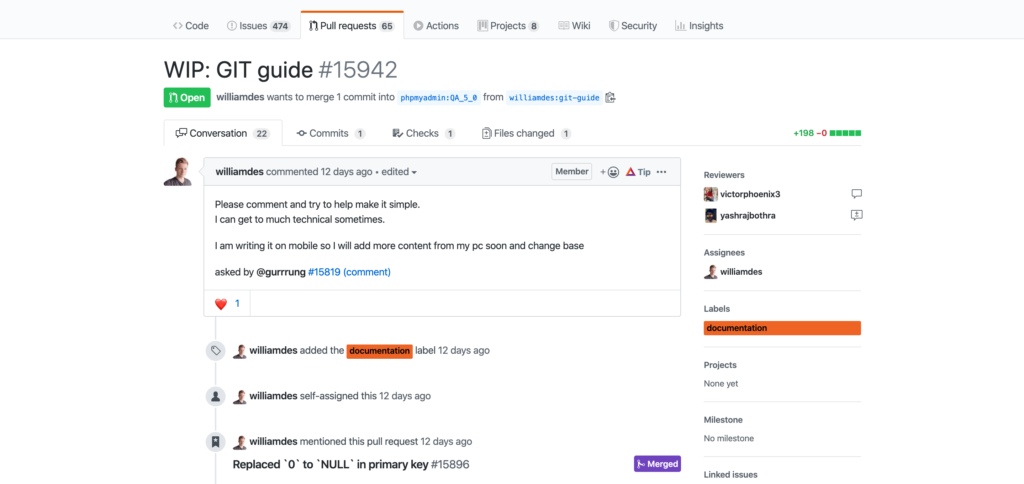10 Git Techniques You Need to Know Before You Join a Team

Have you been using Git for some time but never in a team environment? Are you familiar with the basics of Git but unsure how large teams use Git at work?
In this post, I’ll talk about the basic Git techniques that you must be familiar with before you join a team. I’ve listed them in an order that you’d logically follow to contribute to a repository, as the importance of each step is paramount. Let’s now jump into the list.
Key Takeaways
- Understanding the basics of Git, such as creating and cloning repositories, committing changes, and pushing and pulling data from remote repositories is crucial before joining a team.
- Familiarity with branching and merging is essential as it allows multiple developers to work on different parts of a project simultaneously without affecting the main codebase.
- Knowledge of resolving merge conflicts is vital as it ensures smooth merging of different branches.
- Learning how to use Git Large File Storage for handling large binary files can prevent the repository size from increasing with every commit.
1. Cloning: Getting Started in a Team
If you’ve used Git for personal projects, you may only have initialized a project from scratch and added to it over time. When you’re working on an existing codebase, the first step is to clone the codebase into your local system. This enables you to work on your copy of the repository without any interference from other changes.
To clone a repository, run the git clone command, followed by the path to the repository:
git clone /path/to/repo
If your source doesn’t reside in the same system, you can SSH to a remote system and clone too:
git clone username@remote_system_ip:/path/to/repo/on/remote
If you’re cloning from a source on the Internet, you can simply add the URL:
git clone https://github.com/sdaityari/my_git_project.git
Whenever you’re cloning a repository, you’ve the choice of multiple protocols to connect to the source. In the GitHub example above, I’ve used the https protocol.
2. Managing Remotes in Git
Once you’ve cloned your repository, it still maintains a pointer to the source. This pointer is an example of a remote in Git. A remote is a pointer to another copy of the same repository. When you clone a repository, a pointer origin is automatically created which points to the source.
You can check a list of remotes in a repository by running the following command:
git remove -v
To add a remote, you can use the git remote add command:
git remote add remote_name remote_address
You can remove a remote using the git remote remove command:
git remote remove remote_name
If you’d like to change the address of a remote, you can use the set-url command:
git remote set-url remote_name new_remote_address
3. Branching in Git
The biggest advantage of Git over other version control systems is the power of its branches. Before I jump into the essentials of branching, you may be wondering what a branch is. A branch is a pointer to a commit in your repository, which in turn points to its predecessor. Therefore, a branch represents a list of commits in chronological order. When you create a branch, you effectively create only a new pointer to a commit. However, in essence, it represents a new, independent path of development.
If you’ve been working on your own project, you may never have consciously used branches. By default, Git uses the master branch for development. Any new commits are added to this branch.
Branching is necessary for Git to bifurcate lines of work in a project. At a single time, there may be many developers who are working on a variety of different problems. Ideally, these problems are worked on in different branches to ensure logical separation of new code until code review and merge.
To check a list of branches and the current active branch, run the following command:
git branch
To create a new branch, run the following command:
git branch new_branch
Even though Git creates a new branch, notice that your active branch is still the old one. To start development in a new branch, run the following:
git checkout new_branch
To create a new branch and change the active branch, run the following command:
git checkout -b new_branch
To rename the current branch, run the following command:
git branch -m new_renamed_branch
Use the -D option to remove a branch:
git branch -D new_renamed_branch
Here’s a detailed guide on branching in Git.
4. Update your Local Repository: Merging
While we’ve checked the basics of branching in Git, the next logical step is to merge a branch into your base branch when you’ve finished working on a problem. To merge a branch, run the following command:
git checkout base_branch
git merge new_branch
While it may sound like an easy process, merging is potentially the most time-consuming process in Git, as it can give rise to conflicts.
5. Handle Conflicts
Imagine that you’re working on a file in a new branch. After you commit the changes, you request Git to merge your new branch with your base branch. However, the same part of the same file in the base branch has been updated since you created the new branch. How does Git decide which changes to keep and which changes to discard?
Git always tries to not lose any data in the process of a merge. If the changes to the same file were done in different parts of the file, you could get away by keeping both sets of changes. However, if Git is unable to decide which changes to keep, it raises a conflict.
When a conflict has been raised, running git status on your repository shows a list of files that were modified in both branches being merged. If you open any file with a conflict, you’d notice the following set of lines:
<<<<<<<< HEAD
...
...
========
...
...
>>>>>>>> new_branch
The part of the file between <<<<<<<< HEAD and ======== contains that code which is present in the base branch. The lines of code between ======== and >>>>>>>> new_branch are present in the new_branch branch. The developer who’s merging the code has the responsibility to decide what part of the code (or a mix of both parts) should be included in the merge. Once edited, remove the three sets of lines shown, save the file, and commit the changes.
6. Synchronize Changes with the Remote
While we’ve discussed how to commit code in new branches, and merge it with the base branch, let’s now see how you can synchronize code with the remote. Before you can publish your changes to the remote, you need to update your local copy of the repository to account for any changes that may have occurred since your last update. To update changes from the remote, run the following command:
git pull remote remote_branch:local_branch
The git pull command first downloads the data from the remote and then merges with the local branch as specified in the command. Conflicts can arise while pulling changes from a remote too. In such a case, the last line in a conflict file would contain >>>>>>>> commit_hash instead of >>>>>>>> new_branch, where commit_hash would be the identifying hash for the commit being added to your branch.
To publish changes to the remote after merging with the latest code from the remote, use the git push command:
git push remote local_branch:remote_branch
7. Git on the Cloud: Forking
If your team works on the cloud, you’re introduced to an added concept called a fork. A fork is a copy of the central repository of the cloud under your username. You have write access to your fork, which is a safe place for you to push changes without affecting the original repository.
This affects the very technique step that I covered above. You clone your fork, so the origin of your local repository points to your fork on the cloud. How do you get the updates from the latest repository then? You need to manually add a remote, upstream, which points to the original repository.
While you can easily publish changes to your fork, how do you get new code accepted into the original repository? That brings us to the next step.
8. Code Reviews through Pull Requests
A pull request is a request to merge code from a branch to another. It’s a concept that has developed since cloud services for Git became popular. A pull request summarizes the comparison between the two branches in question and initiates a discussion between the developer and the organization’s admins.

A code review may culminate in more changes before it can be merged. When the admins are satisfied with the changes, it can be merged with the repository.
9. Know About Git Workflows
When you’re working alone on a single project, you’re probably using just a single branch. Unknowingly, you’re adhering to the centralized or trunk workflow, where all changes are made to a single branch.
The next, more complex workflow is the feature-branch workflow, where a single branch is attributed to each feature or bug fix. No development happens directly on the master or development branches.
A Git workflow that encompasses a wide range of situations is the Gitflow workflow. It has separate branches for development, features, releases and hotfixes.
Here’s a detailed guide on Git workflows.
10. Handle Large Files: Git LFS
While Git does a great job of handling text files, it’s unable to track changes in binary and executable files. While you can add such files to Git, it could potentially lead to a large repository size with an increase in the number of commits.
The solution is to use Git Large File Storage, which handles large binary files through Git. This tool stores these files on the cloud, and replaces them with text pointers. Here’s an implementation of using Git LFS to track Photoshop design files.
Further Reading
In this post, I’ve talked about various Git techniques that may help you when joining a team for the first time. I hope it’s helped you in your preparation for the future. Did I miss out on anything? Do let me know on Twitter!
For a deeper understanding of Git, check out these resources:
- Jump Start Git: A concise guide that will get you up to speed in a single weekend.
- Professional Git: A deeper dive that’ll take you on the path to Git mastery.
Frequently Asked Questions (FAQs) about Git Techniques
What are the essential Git techniques I should know before joining a team?
Before joining a team, it’s crucial to understand the basics of Git, such as creating and cloning repositories, committing changes, and pushing and pulling data from remote repositories. Additionally, you should be familiar with branching and merging, which allow you to work on different parts of a project simultaneously without affecting the main codebase. Understanding how to resolve merge conflicts is also important. Lastly, knowing how to use Git’s log to track changes and Git’s stash command to save changes that you don’t want to commit immediately can be very helpful.
How can I effectively use Git in a team setting?
In a team setting, communication is key. Always pull the latest changes before starting your work and push your changes as soon as you’re done. Use clear and concise commit messages to describe what you’ve done. Make use of branches for developing new features or fixing bugs. Regularly sync your local repository with the remote one to stay updated with the team’s progress.
What is the role of Git in version control?
Git is a distributed version control system that tracks changes to a codebase. It allows multiple developers to work on the same project simultaneously without overwriting each other’s changes. Git keeps a history of all changes made to the code, making it easy to revert back to a previous version if needed.
How can I resolve merge conflicts in Git?
Merge conflicts occur when Git is unable to automatically merge changes from different branches. To resolve them, you need to manually edit the conflicting files, decide which changes to keep, and then commit the resolved files. Git provides tools like ‘git diff’ to help you identify and resolve these conflicts.
What is the purpose of Git branches and how do I use them?
Git branches allow you to work on different features or bugs without affecting the main codebase. To create a new branch, use the ‘git branch’ command followed by the branch name. To switch to a branch, use ‘git checkout’ followed by the branch name. Once you’re done with your changes, you can merge your branch back into the main branch using ‘git merge’.
How can I track changes in Git?
Git provides a ‘log’ command that shows a history of all commits made to the repository. Each commit has a unique ID, the author’s name and email, the date and time of the commit, and the commit message. You can use this command to track changes and find specific commits.
What is Git stash and how do I use it?
Git stash is a command that allows you to save changes that you don’t want to commit immediately. This is useful when you need to switch branches but don’t want to lose your current work. To stash your changes, use the ‘git stash’ command. To apply your stashed changes, use ‘git stash apply’.
How can I clone a Git repository?
To clone a Git repository, use the ‘git clone’ command followed by the URL of the repository. This will create a copy of the repository on your local machine, allowing you to work on the project and push your changes back to the remote repository.
How can I revert changes in Git?
To revert changes in Git, you can use the ‘git revert’ command followed by the ID of the commit you want to revert. This will create a new commit that undoes the changes made in the specified commit.
How can I contribute to a Git project?
To contribute to a Git project, you first need to fork the repository. This creates a copy of the repository under your own account. You can then clone this repository, make your changes, and push them back to your fork. Finally, you can open a pull request to propose your changes to the original repository.
Shaumik is a data analyst by day, and a comic book enthusiast by night (or maybe, he's Batman?) Shaumik has been writing tutorials and creating screencasts for over five years. When not working, he's busy automating mundane daily tasks through meticulously written scripts!





